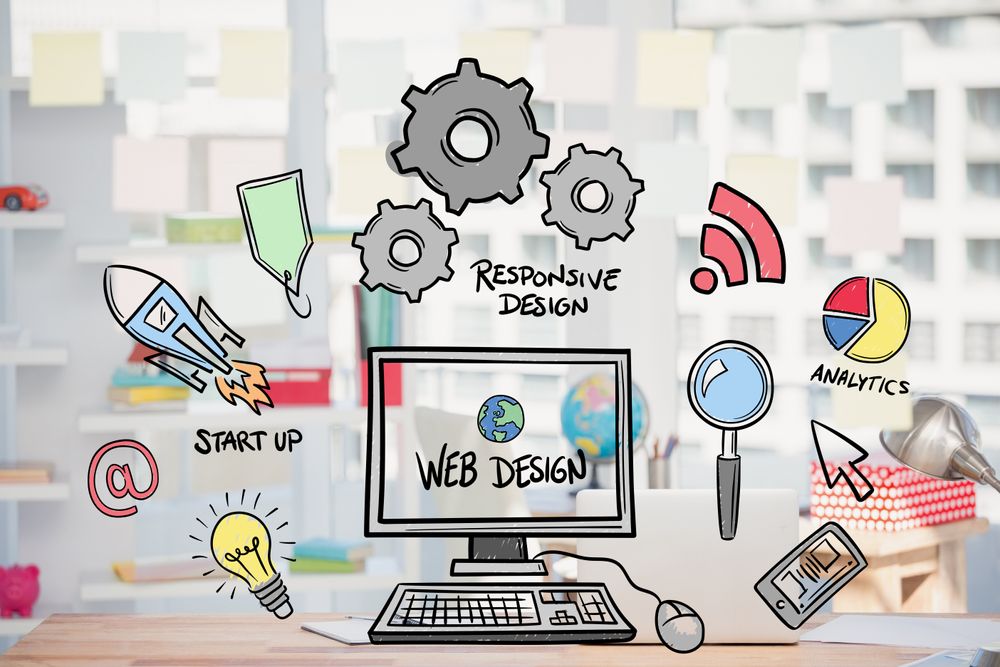Best Web Design services that empower businesses build stronger online brands
Wiki Article
Discovering Creative Patterns in Web Design for Modern Businesses
The landscape of web design is constantly advancing, mirroring the dynamic demands of modern companies. Recent fads highlight a choice for minimalism, strong typography, and interesting interactivity. Business significantly focus on user experience via mobile-first concepts and tailored web content. Furthermore, a focus on sustainability is acquiring traction. Understanding these trends is necessary for services aiming to attract attention in a jampacked market. What ramifications do these shifts hold for the future of digital involvement?Accepting Vibrant Typography
Bold typography has actually become a defining component in contemporary web design, capturing interest and conveying messages with striking clarity. This fad focuses on aesthetically impactful message that boosts user interaction and brand identity. Designers commonly use distinct typefaces and large fonts to produce a hierarchy, leading customers through material seamlessly.
The critical use of vibrant typography permits reliable storytelling, allowing brand names to communicate their values succinctly. It serves not only visual objectives yet also practical ones, as it improves readability throughout gadgets and display dimensions.
As internet sites contend for user focus, vibrant typography attracts attention in a saturated digital landscape. Its adaptability makes it possible for designers to explore contrasting shades and layouts, additionally enhancing its effectiveness. Ultimately, accepting strong typography stands for a change towards more expressive and communicative web design, promoting a deeper link between brands and their audiences.
The Rise of Minimalist Style
As electronic atmospheres end up being significantly messy, the rise of minimal design supplies an invigorating alternative that focuses on simplicity and capability. This design viewpoint strips away unneeded aspects, permitting material to take facility stage. By focusing on clean lines, ample white room, and a restricted color palette, minimal design boosts user experience and boosts navigating.Organizations embracing this trend purpose to convey their brand message plainly and efficiently, promoting a feeling of calmness and quality. The absence of distractions helps individuals concentrate on necessary details, bring about boosted involvement and conversion rates. Furthermore, minimalist design aligns well with mobile-first methods, making sure that internet sites remain straightforward and obtainable throughout various tools.
Ultimately, the increase of minimalist layout mirrors a broader shift in the direction of focusing on user needs and choices, making it an effective device for contemporary services wanting to make a long lasting influence in the electronic landscape.
Immersive Animations and Interactivity
While numerous web developers welcome minimalist looks, another engaging trend getting traction is the usage of immersive animations and interactivity. This strategy improves user interaction by producing appealing experiences that draw site visitors right into the web content. Developers utilize dynamic elements such as animated backgrounds, scrolling results, and interactive infographics to communicate complex ideas in an obtainable way.These computer animations not only provide aesthetic interest but also overview users with the navigation procedure, making communications a lot more user-friendly. Float impacts and computer animated changes can motivate customers to discover better, leading to increased time spent on the site.
This trend straightens with the more comprehensive motion in the direction of storytelling in web style, where animations offer as narrative tools that communicate brand name messages successfully. By incorporating immersive computer animations and interactivity, services can differentiate themselves in a jampacked online landscape, inevitably boosting user satisfaction and brand name loyalty.
Mobile-First Design Principles
Mobile-first design concepts emphasize focusing on user experience by making certain websites work seamlessly on smaller sized screens. This technique incorporates receptive layout strategies that adapt to numerous tool dimensions while keeping visual stability. Additionally, it concentrates on touchscreen navigating design, enhancing usability for mobile users.Prioritizing User Experience
Just how can designers efficiently prioritize user experience in an increasingly mobile-centric globe? Emphasizing mobile-first layout concepts is important, as customers primarily involve with internet sites via smart phones. This strategy urges designers to enhance web content, ensuring it is accessible and conveniently available on smaller sized screens. Key practices consist of simplifying navigation, minimizing lots times, and utilizing touch-friendly aspects that improve interactivity. In addition, prioritizing readable typography and user-friendly formats can greatly enhance user complete satisfaction. Developers need to constantly collect user comments to refine their techniques, adapting to developing user Source demands and preferences. By concentrating on these aspects, companies can produce an engaging digital experience that cultivates loyalty and drives conversions, inevitably lining up with the expectations of today's mobile customers.Responsive Layout Techniques
Designers embrace receptive design techniques to create versatile and flexible web experiences that satisfy numerous screen sizes. This strategy focuses on mobile-first style concepts, making certain peak capability on smaller sized devices before scaling up for bigger displays. By using fluid grids, adaptable photos, and media queries, designers can keep a natural aesthetic identification across all platforms. This approach not only enhances user involvement however likewise boosts search engine rankings, as mobile-friendly sites are preferred by search formulas. In addition, responsive layouts permit companies to get to a broader audience, suiting users on desktops, smart devices, and tablet computers alike. On the whole, implementing these strategies is essential for modern web design, making certain that businesses stay affordable in an ever-evolving digital landscape.Touchscreen Navigation Layout
With the rise of mobile phones, touchscreen navigation has come to be a basic aspect of web design. Developers are significantly embracing mobile-first concepts to boost user experience and interaction. agency for web design. Reliable touchscreen navigation prioritizes bigger buttons and intuitive gestures, enabling users to engage quickly with content. This strategy minimizes disappointment and urges expedition, as users can navigate seamlessly with their fingers. Additionally, including swipe motions and tap performance caters to the all-natural habits of mobile customers. Comments systems, such as aesthetic hints and computer animations, enhance use better by validating activities. As touchscreens control user interactions, employing these layout components not only straightens with modern assumptions but additionally promotes a much more satisfying and easily accessible searching experience for all customersPersonalized User Experiences
What makes an individual really feel absolutely involved on an internet site? The solution usually lies in customized user experiences. By tailoring content and navigating to private preferences, services can develop a purposeful link with their audience. This customization can be accomplished through numerous techniques, such as examining user behavior, using cookies, and providing personalized suggestions based upon previous interactions.For example, ecommerce systems that suggest products based on browsing history not only boost user experience yet additionally boost conversion rates. Including vibrant material that adjusts to the user's place or time of day can even more enhance engagement.
In addition, customized greetings or messages can make users feel valued and understood. As modern services seek to attract attention in an affordable electronic landscape, embracing tailored user experiences comes to be crucial, promoting commitment and encouraging repeat check outs. Ultimately, this technique transforms a standard web site right into an interactive platform that resonates with its target market.
Sustainability in Web Design
As the digital landscape continues to develop, the relevance of sustainability in web design has gained considerable focus. Developers are progressively familiar with the environmental effect their productions can have, motivating a shift in the direction of environment-friendly techniques (Web Design Agency). Sustainable web design concentrates on optimizing sites to decrease power intake and carbon footprints. Approaches include utilizing minimalistic style concepts, optimizing images, and employing effective coding methods to boost loading ratesFurthermore, the option of hosting carriers plays a crucial function; many designers are now selecting environment-friendly organizing solutions powered by sustainable energy. By prioritizing availability and user-friendly navigation, sustainable styles likewise learn this here now accommodate a broader audience, improving use. This aware technique not only interest environmentally-minded customers yet additionally adds to the total longevity and efficiency of websites. Inevitably, sustainability in web design shows a growing trend in the direction of liable digital techniques that line up with modern company values.

Often Asked Inquiries
How Can I Choose the Right Shade System for My Internet site?
To select the ideal color design for a site, one need to consider the brand name's identification, target market, and emotional impact. Using color concept and testing combinations can improve user experience and visual appeal substantially.What Are the most effective Tools for Prototyping Website Design?
The most effective tools additional info for prototyping web styles consist of Figma, Map out, Adobe XD, and InVision. These systems supply intuitive interfaces, partnership functions, and considerable collections, making them optimal for designers to develop and refine their principles successfully.Exactly how Do I Measure the Efficiency of My Web Design?
To measure web design efficiency, one should assess user interaction metrics, conversion prices, and functionality comments (agency for web design). A/B testing and heatmaps can likewise supply understandings into user behavior, guiding necessary adjustments for improved performance and user experienceWhat Are Common Web Design Mistakes to Stay Clear Of?
Usual web design errors consist of messy designs, poor navigation, slow-moving packing times, lack of mobile optimization, insufficient contrast, and disregarding user responses. Avoiding these challenges enhances user experience and raises general effectiveness of the internet site.How Often Should I Update My Website Style?
A site style need to be updated every 2 to 3 years, or faster if considerable adjustments in branding or technology occur. Regular updates keep the website fresh, functional, and aligned with current user expectations.
Report this wiki page